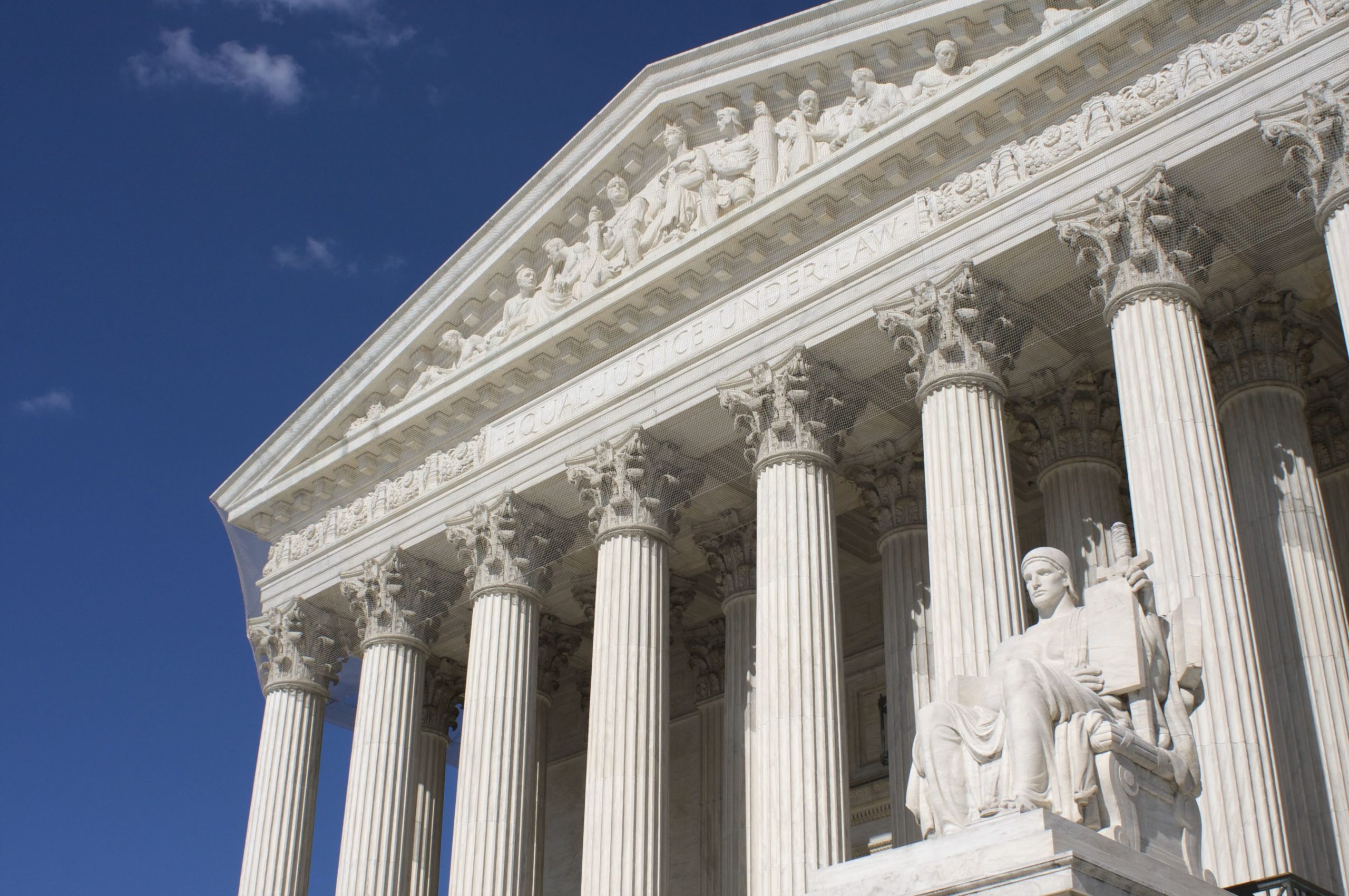Court rules for South Carolina Republicans in dispute over congressional map


The Supreme Court on Thursday threw out a ruling by a federal district court holding that a congressional district on the South Carolina coast was an unconstitutional racial gerrymander – that is, it sorted voters based primarily on their race. In an opinion by Justice Samuel Alito, the justices cleared the way for the state to use the map going forward. The 6-3 decision, with the justices divided on ideological lines, means that the disputed district will remain a safe seat for Republicans, who hold a 6-1 advantage in the state’s congressional delegation. More broadly, Thursday’s decision creates a high bar for plaintiffs in future racial gerrymandering cases to meet.
The issue at the center of the case was how courts should distinguish between the roles played in redistricting by race and party affiliation, when there are often close correlations between the two. In South Carolina, for example, exit polls in the 2020 election indicated that at least 90% of Black voters supported Democrat Joe Biden.
A lower court in March ordered the map to be used for the 2024 elections, after the Supreme Court failed to rule in the case by a proposed Jan. 1 deadline.
In his opinion for the majority, Alito rejected the lower court’s conclusion that the state’s Republican-controlled legislature had improperly relied too heavily on race in drawing the challenged district. “[I]nferring bad faith based on the racial effects of a political gerrymander in a jurisdiction in which race and partisan preference are very closely correlated” would, Alito suggested, allow litigants and courts to circumvent the Supreme Court’s 2019 decision in Rucho v. Common Cause, holding that federal courts should not consider claims of partisan gerrymandering. Specifically, Alito posited, litigants could simply “repackage” their claims that legislatures relied too heavily on partisanship as contentions that the legislatures relied too much on race.
Joined by Justices Sonia Sotomayor and Ketanji Brown Jackson, Justice Elena Kagan dissented from the court’s decision. Kagan took a very different view of the effects of Thursday’s decision, writing that it told legislators who wanted to rely on race – either “as a proxy to achieve partisan ends” or to “straight-up suppress the electoral influence of minority voters” – to “[g]o right ahead.” Legislators and mapmakers, she complained, can evade scrutiny by explaining that they relied on factors other than race.
The case began in 2021, when the legislature drew the district at the center of the dispute, known as District 1. The South Carolina chapter of the NAACP and Taiwan Scott, a Black voter who lives in the district, went to federal court to challenge the district as the product of racial gerrymandering. The new map moved nearly two-thirds of the Black voters in Charleston County out of District 1, they noted, which is currently represented by Republican Nancy Mace, into District 6, represented by Democrat Jim Clyburn. The map also moved Republican areas in nearby Beaufort, Berkeley, and Dorchester Counties into District 1 from District 6.
Defending the plan, the state argued that the legislature’s goal in enacting the map was to ensure that the district remained a safe seat for Republicans: Although the district had historically elected Republicans since 1980, in 2018 a Democrat, Joe Cunningham, won in an upset. Mace defeated him in 2020 by less than 1%.
In Jan. 2023, a three-judge federal district court – which hears challenges to the constitutionality of a congressional map – agreed with the challengers that District 1 violated the Constitution because it was the product of racial gerrymandering. The court ordered the state to draw a new map, although that order had been on hold awaiting the Supreme Court’s decision.
In a 34-page opinion, Alito stressed the high bar that plaintiffs bringing a racial gerrymandering case must meet, observing that the court had “repeatedly emphasized that federal courts must ‘exercise extraordinary caution in adjudicating claims that a State has drawn district lines on the basis of race.” “Such caution,” he explained, “is necessary because “[f]ederal-court review of districting legislation represents a serious intrusion on the most vital of local functions.”
Thus, Alito continued, plaintiffs in racial gerrymandering cases must first “disentangle race and politics” – that is, to show that race was the primary factor behind the legislature’s decision to move voters into or out of a district. They can do so using direct evidence, Alito wrote, or circumstantial evidence, although relying solely on circumstantial evidence makes their task “much more difficult.” This is particularly true, Alito added, when the state counters that the moves were made for partisan reasons, rather than on the basis of race.
And nearly a quarter-century ago, Alito noted, the Supreme Court suggested that one way for plaintiffs to clear the “high bar” for racial gerrymandering cases would be to submit their own map, showing that a legislature could have drawn a different map that achieved the state’s political goals but without relying so heavily on race. If plaintiffs cannot provide such a map, Alito emphasized, “it is difficult for plaintiffs to defeat our starting presumption that the legislature acted in good faith.” Such a presumption, Alito wrote, “reflects the Federal Judiciary’s due respect for the judgment of state legislators” and avoids the declaration “that the legislature engaged in ‘offensive and demeaning conduct'” that would flow from a finding that “race drove a legislature’s districting decisions.”
Applying this standard to the case before him, Alito observed that the plaintiffs needed to show that the legislature put race before other traditional redistricting principles when drawing District 1. The lower court’s conclusion that they had met this “demanding” standard, he wrote, was “clearly” wrong: “They provided no direct evidence of a racial gerrymander, and their circumstantial evidence is very weak,” relying on “deeply flawed expert reports.” Moreover, he added, the plaintiffs’ experts did not provide a map that achieved the legislature’s goal of making the seat a safer one for Republicans while putting more Black voters in the district.
The court sent the case back for the lower court to take another look at the plaintiffs’ claim that the 2021 map also diluted the votes of Black voters – an issue on which the plaintiffs had also prevailed below.
In her 34-page dissent, Kagan characterized the majority opinion as “seriously wrong.” She first lamented that the majority should have been more deferential to the lower court’s findings about the facts of the case and the legislators’ motives. The Supreme Court, she said, is required to give such findings “significant deference” as long as they are “plausible.” But although the plaintiffs “introduced more than enough evidence of racial gerrymandering to support the District Court’s judgment,” she wrote, the majority substitutes its own judgment for that of the lower court, even on questions like the credibility of witnesses that are the quintessential purview of trial judges.
But to “justify its ruling on the facts,” Kagan continues, the majority must “rework[] the law” in two different ways that will make it harder for plaintiffs to prevail in future racial gerrymandering cases as well. First, Kagan challenged the majority’s reliance on a presumption that the legislature has acted in good faith. The majority’s “approach,” Kagan wrote, “conflicts with this Court’s precedent.” Although the presumption “tells a court not to assume a districting plan is flawed or to limit the State’s opportunities to defend it,” and “reminds a court that it is a serious matter to find a State in breach of the Constitution,” there is nothing in the Supreme Court’s decisions holding that “a trial court must resolve every plausibly disputed factual issue for the State.”
Second, Kagan accused the majority of “invent[ing] a new rule of evidence” – the submission of an alternative map – “to burden plaintiffs in racial-gerrymandering cases.” “Such micromanagement of a plaintiff’s case is elsewhere unheard of in constitutional litigation,” Kagan wrote.
But, Kagan concluded, “[p]erhaps most dispiriting is what lies behind the Court’s new approach — its special rules to specially disadvantage suits to remedy race-based redistricting.” In her view, instead of “throw[ing] up novel roadblocks enabling South Carolina to continue dividing citizens along racial lines,” the Supreme Court should instead have upheld the “more than plausible” conclusion of the lower court that District 1 was an unconstitutional racial gerrymander and should be redrawn.
Justice Clarence Thomas filed an opinion concurring in part with the majority. He contended that Alito’s “searching review” of the expert reports went beyond the kind of scrutiny normally used for factual findings by lower courts. But it ultimately didn’t matter, Thomas continued, because the lower court made legal errors – for example, failing to look at evidence regarding the correlation between race and politics “with the necessary presumption of legislative good faith” and failing to take into account the lack of an alternative map by the plaintiffs – that warranted reversal. But he wrote separately – in a 29-page opinion – to set out his view that federal courts should not have the power to weigh in on racial gerrymandering and vote dilution claims.
Both the challengers and the state had asked the Supreme Court to issue its decision by Jan. 1, 2024. When the court had not yet acted by mid-March, the Republican legislators returned to the court, seeking to be allowed to use the 2021 map for the 2024 elections even though the lower court had ruled that District 1 was an unconstitutional racial gerrymander.
Before the Supreme Court could act on the legislators’ request, however, the three-judge district court issued an order leaving the 2021 map in place for the 2024 elections. In an order on March 28, the district court concluded that, “with the primary election procedures rapidly approaching, the appeal before the Supreme Court still pending, and no remedial plan in place, the ideal must bend to the practical.”
This article was originally published at Howe on the Court.
Posted in Merits Cases
Cases: Alexander v. South Carolina State Conference of the NAACP